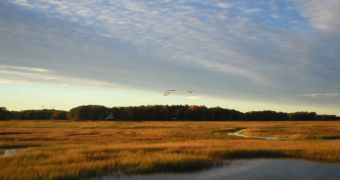Climate change and future sea-level rises could be the end of many coastal wetlands all over the world, according to US Geological Survey scientists, who also identified the conditions under which coastal wetlands could survive rising waters.
If the sea level rises rapidly, most coastal wetlands will disappear before the end of this century, like some coastal marshes along the east coast of the United States, including the Plum Island Estuary (the largest estuary in New England) and coastal wetlands in North Carolina's Albemarle-Pamlico Sound (the second-largest estuary in the United States).
On the other hand, if the sea level rises slowly, there are two possibilities: wetlands with low sediment availability and low tidal ranges are vulnerable and may drown, but wetlands with higher sediment availability have more chances of survival.
The scenario of the rapid sea-level rise is accredited to Stefan Rahmstorf at Potsdam University, one of the contributing authors of the Intergovernmental Panel on Climate Change Fourth Assessment Report.
The slow sea-level rise scenario, is part of the A1B scenario of the Intergovernmental Panel on Climate Change Fourth Assessment Report.
USGS scientists calculated the sediment levels and tidal ranges that are necessary for marshes to survive sea-level rise.
They concluded that if water floods a wetland and flows through its vegetation, sediment is carried from upstream and deposited on the wetland's surface, rising its level.
High tidal ranges favor better sediment delivery, so the higher the sediment concentrations in the water, the higher the wetlands become.
USGS scientist Glenn Guntenspergen, an author of this report, explained that “accurate information about the adaptability of coastal wetlands to accelerations in sea-level rise, such as that reported in this study, helps narrow the uncertainties associated with their disappearance.
“This research is essential for allowing decision makers to best manage local tradeoffs between economic and conservation concerns.”
Matt Kirwan, USGS scientist and an author of the report added that “previous assessments of coastal wetland responses to sea-level rise have been constrained because they did not consider the ability of wetlands to naturally modify their physical environment for adaptation.
“Failure to incorporate the interactions of inundation, vegetation and sedimentation in wetlands limits the usefulness of past assessments.”
Coastal wetlands are very important as they absorb energy from coastal storms, maintain shorelines, help keep people and infrastructures safe, support commercial seafood harvests, absorb pollutants and provide a habitat to migratory bird populations.
So if the wetlands are underwater all of these resources and services will be threatened.
US. Geological Survey scientists published this research modeling in the journal Geophysical Research Letters, a publication of the American Geophysical Union.

 14 DAY TRIAL //
14 DAY TRIAL //